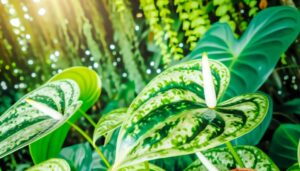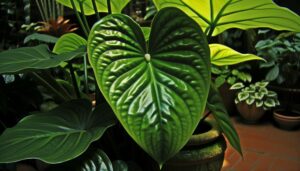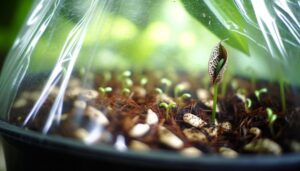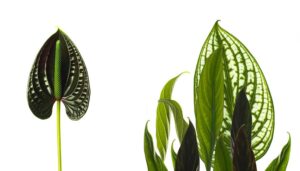Why Is Anthurium Hookeri Variegated Unique? Discover!
Anthurium Hookeri Variegated is distinguished by its unique variegation patterns, characterized by chlorophyll-deficient and chlorophyll-rich sections on its foliage. This variegation is attributed to genetic mutations affecting chloroplast development, leading to patches lacking chlorophyll and impacting photosynthetic efficiency.
The plant’s broad, lanceolate leaves feature a striking contrast between green and white areas, enhancing its aesthetic appeal. Additionally, the plant’s rarity and intricate genetic mechanisms contribute to its high desirability among enthusiasts.
Thorough insights into its genetic marvel and visual charm underscore its unique status, suggesting there is more to discover.
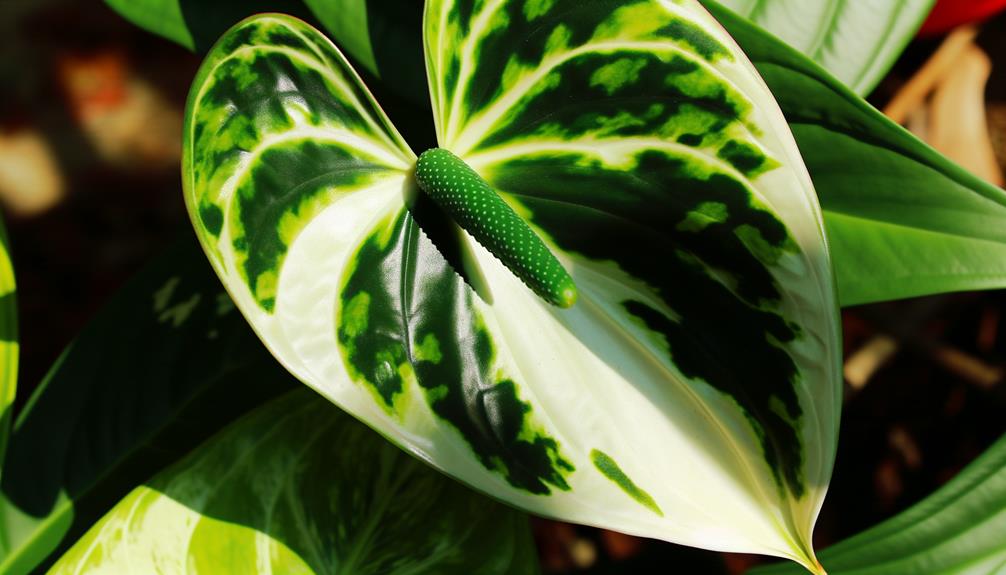
Key Takeaways
- Genetic Mutations: The unique variegation arises from genetic mutations affecting chlorophyll production.
- Aesthetic Appeal: Striking contrasts between chlorophyll-deficient and chlorophyll-rich sections create a visually enchanting mosaic.
- Rarity: Limited availability and unique patterning make it highly desirable among collectors and enthusiasts.
- Air Quality Benefits: Enhances indoor air quality by absorbing pollutants and increasing oxygen production.
- Low Maintenance: Despite its exotic appearance, it is a robust and low-maintenance plant suitable for indoor environments.
Unique Variegation Patterns

The Anthurium Hookeri Variegated is distinguished by its unique variegation patterns, which exhibit a rare combination of chlorophyll-deficient and chlorophyll-rich sections on its foliage.
This variegation results in visually striking leaves where the interspersed white or yellow sections contrast sharply with the green areas.
The phenomenon is not merely aesthetic; it also alters the plant’s photosynthetic efficiency. Studies indicate that such variegation is due to localized genetic mutations affecting chloroplast development.
Consequently, the variegated regions lack chlorophyll, inhibiting their ability to perform photosynthesis effectively.
This creates a patchwork of functional and non-functional photosynthetic areas, rendering this plant a fascinating subject for botanical research. This distinct pattern greatly enhances its desirability among plant enthusiasts and collectors.
Genetic Marvel Explained
The genetic mechanism underlying the variegation in Anthurium Hookeri Variegated is primarily attributed to specific mutations affecting chlorophyll production.
Recent studies have revealed the origins of these mutations, linking them to both nuclear and plastid genomic changes.
Inheritance patterns investigated through controlled breeding experiments reveal a complex interplay of dominant and recessive alleles influencing the variegation phenotype.
Variegation Genetic Mechanism
Variegation in Anthurium Hookeri Variegated results from a complex interplay of genetic mutations that lead to the mosaic-like appearance of different colored tissues.
These mutations often involve the chloroplasts, the cellular structures responsible for photosynthesis, causing a disruption in chlorophyll production and distribution.
The genetic mechanism behind variegation can be elucidated by examining several key factors:
- Chimeric Tissues: Presence of genetically distinct cell layers within the same plant.
- Transposons: Mobile genetic elements that can insert themselves into genes involved in pigment production.
- Epigenetic Modifications: Changes in gene expression without altering the DNA sequence itself.
- Somatic Mutations: Mutations occurring in non-reproductive cells that can lead to variegated phenotypes.
Understanding these mechanisms provides insight into the unique visual characteristics of Anthurium Hookeri Variegated.
Mutation Origins Unveiled
Unraveling the origins of these mutations requires an in-depth exploration into both spontaneous genetic changes and inherited genetic variability.
Spontaneous mutations can occur due to errors in DNA replication or exposure to environmental mutagens such as UV radiation. These alterations in the genetic code may lead to the variegated patterns observed in Anthurium Hookeri.
Inherited genetic variability, on the other hand, refers to the natural genetic diversity within the species that can give rise to unique phenotypic expressions.
Molecular studies, including DNA sequencing and chromosomal analysis, have identified specific loci associated with variegation traits.
These genetic marvels not only enhance the aesthetic appeal of Anthurium Hookeri but also provide valuable insights into plant developmental biology and evolutionary processes.
Inheritance Patterns Studied
Building on the understanding of mutation origins, researchers have now meticulously mapped the inheritance patterns of variegation in Anthurium Hookeri.
Through genomic sequencing and controlled breeding experiments, scientists have identified specific genetic markers linked to the variegated phenotype.
This advancement allows for a deeper comprehension of the complex hereditary mechanisms involved.
- Dominant and Recessive Alleles: Variegation is influenced by the interaction of dominant and recessive alleles.
- Epigenetic Factors: External factors play a role in gene expression related to leaf variegation.
- Chimeral Nature: Variegation may result from the chimeral nature of plant cells, containing genetically distinct tissues.
- Phenotypic Plasticity: Environmental conditions can modulate the expression of variegation, adding a layer of complexity.
This investigation provides pivotal insights into the genetic marvel of Anthurium Hookeri variegation.
Visual Appeal

The distinct visual appeal of Anthurium Hookeri Variegated lies in its strikingly patterned foliage, characterized by a unique interplay of green and white hues.
This variegation results from genetic mutations affecting chlorophyll distribution, creating an aesthetically pleasing mosaic.
The leaves’ broad, lanceolate shape further accentuates the contrast between the vibrant green and the creamy white patches.
| Feature | Description | Scientific Basis |
|---|---|---|
| Color Variation | Green and white variegation | Chlorophyll mutation |
| Leaf Shape | Broad, lanceolate | Evolutionary adaptation |
| Texture | Smooth, glossy surface | Epidermal cell structure |
| Growth Pattern | Rosette formation | Genetic regulation |
The visual appeal extends beyond mere color, encompassing the texture and growth pattern, which collectively contribute to its ornamental value.
Growth and Care
Anthurium Hookeri Variegated Unique thrives under specific growing conditions, requiring indirect sunlight and high humidity levels to maintain peak health.
Proper watering practices and balanced fertilization are essential to support its growth and enhance its variegated foliage.
Understanding these fundamental care requirements can greatly enhance the plant’s longevity and aesthetic appeal.
Ideal Growing Conditions
To thrive, Anthurium Hookeri Variegated thrives in a warm, humid environment with well-draining soil and indirect sunlight. Best growth conditions mimic the plant’s native tropical habitat, promoting robust foliage and vivid variegation.
Key considerations include:
- Temperature: Maintain a consistent range between 65°F to 80°F (18°C to 27°C) to support metabolic processes.
- Humidity: High humidity levels, preferably above 60%, are crucial to reduce transpiration stress.
- Soil Composition: Use a well-draining mix, such as orchid bark combined with perlite and peat moss, to avoid waterlogging.
- Light Exposure: Offer filtered light, avoiding direct sunlight, which can cause leaf scorch and lessen variegation.
These parameters help the Anthurium Hookeri Variegated stay healthy and visually appealing.
Watering and Fertilization
Ensuring appropriate watering and fertilization practices is essential for the best growth and care of Anthurium Hookeri Variegated. This plant thrives in consistently moist, but not waterlogged, soil.
Overwatering can lead to root rot, while insufficient watering causes leaf browning. Using a well-draining potting mix is necessary.
Fertilization should be done every other month during the growing season with a balanced, water-soluble fertilizer (e.g., 20-20-20 NPK). Avoid excessive fertilization, as too many nutrients can result in salt build-up and leaf burn. Research shows that controlled-release fertilizers also contribute to ideal growth.
Monitoring the plant’s response to these practices ensures its vibrant variegation and overall health. Maintaining proper watering and fertilization routines is essential for fostering a thriving Anthurium Hookeri Variegated.
Popularity Among Enthusiasts

The variegated Anthurium Hookeri has garnered significant attention among plant enthusiasts due to its unique foliage patterns and rarity.
This distinct cultivar features strikingly variegated leaves, often displaying a blend of green with white or cream-colored streaks, which sets it apart from other species. Its popularity is driven by several factors:
- Aesthetic Appeal: The visually enchanting variegation enhances its decorative value.
- Rarity: Limited availability increases desirability among collectors.
- Genetic Uniqueness: The variegation results from specific genetic mutations, making each plant unique.
- Community Influence: Social media platforms and plant forums amplify its popularity through shared images and cultivation tips.
The combination of these attributes makes the variegated Anthurium Hookeri a coveted addition to any serious plant collection.
Indoor Garden Benefits
Beyond its aesthetic and collectible appeal, the variegated Anthurium Hookeri contributes significantly to the benefits of indoor gardening.
This exotic plant enhances indoor air quality by absorbing airborne pollutants such as formaldehyde, ammonia, and xylene, as supported by studies from NASA’s Clean Air Study.
The large, variegated leaves increase the surface area for photosynthesis, thereby enhancing oxygen production. Additionally, the plant’s robust structure and resilience make it a low-maintenance option, ideal for reducing indoor stress levels.
In addition, the presence of such greenery has been linked to improved mental well-being and productivity, as evidenced by research from the Journal of Environmental Psychology. These multifaceted benefits establish the variegated Anthurium Hookeri as a valuable addition to any indoor garden.
Comparisons to Other Anthuriums
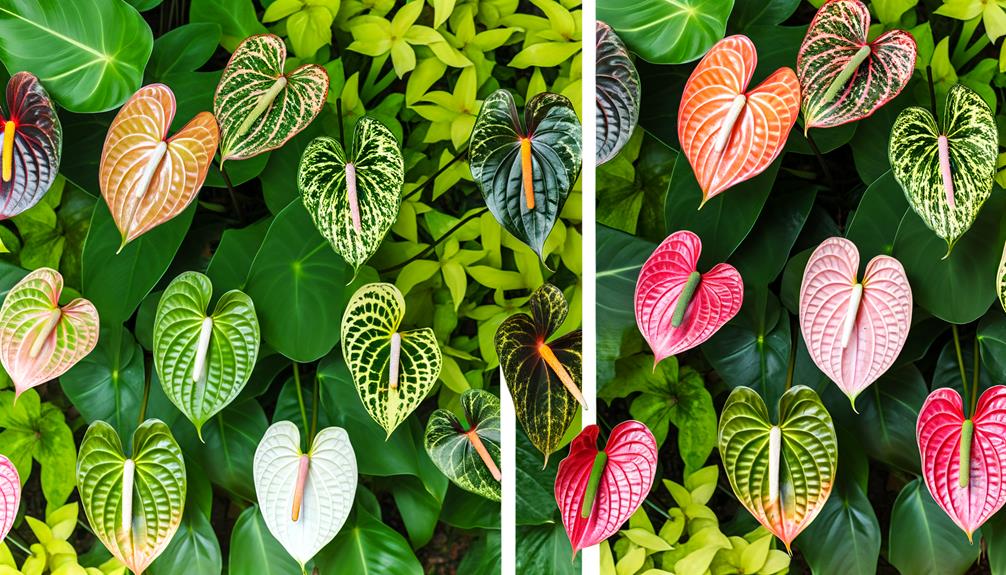
How does the variegated Anthurium Hookeri compare to other Anthuriums regarding botanical characteristics and indoor cultivation requirements?
The variegated Anthurium Hookeri displays distinct features such as uniquely patterned foliage, contributing to its ornamental value.
In comparison to other Anthuriums, it possesses several distinctive traits:
- Leaf Morphology: Exhibits larger, bird’s nest-shaped leaves with striking variegation patterns, unlike the heart-shaped leaves of Anthurium andraeanum.
- Light Requirements: Prefers moderate, indirect light, whereas Anthurium clarinervium thrives in low light conditions.
- Growth Habit: Grows in compact rosettes, contrasting with the climbing habit of Anthurium scandens.
- Humidity Needs: Requires higher humidity levels, similar to other tropical Anthuriums but more critical for maintaining variegation.
These characteristics underscore the unique appeal and specific care needs of the variegated Anthurium Hookeri.
Tips for Plant Care
Understanding the unique characteristics of the variegated Anthurium Hookeri informs its specific care requirements, particularly in relation to lighting, humidity, and growth conditions. Best growth is achieved with bright, indirect light, as direct sunlight can scorch the variegated leaves.
Maintain high humidity levels, ideally between 60-80%, to mimic its native tropical environment. Regular misting or the use of a humidifier may be necessary. The substrate should be well-draining yet moisture-retentive, incorporating components such as peat moss and perlite.
Watering should be consistent but not excessive; allow the top inch of soil to dry out between waterings. Fertilize monthly during the growing season with a balanced, water-soluble fertilizer to support vigorous growth and vibrant variegation.
Conclusion
In summary, Anthurium hookeri variegated stands as a paragon of botanical uniqueness due to its distinct variegation patterns, genetic intricacies, and visual allure.
The plant’s specific care requirements and its rising popularity among horticultural enthusiasts further underscore its exceptional status.
When juxtaposed with other Anthuriums, its singular characteristics are evident.
Truly, ‘beauty is in the eye of the beholder,’ and the Anthurium hookeri variegated offers an unparalleled aesthetic that enhances any indoor garden.

